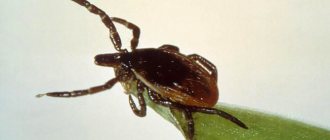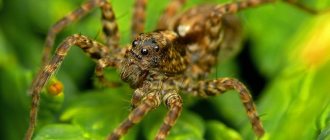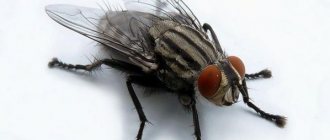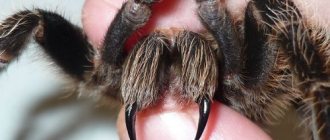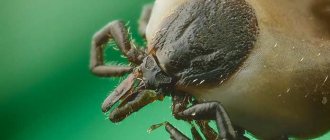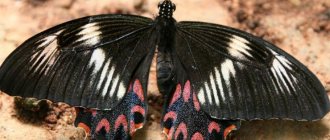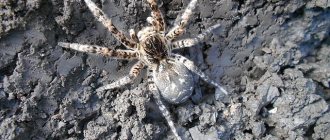Blister beetle
This beetle is known to the world as a locust killer. It has a lot of benefits for gardens and crops. It is common in the southern and southeastern parts of our country. It is dangerous for people due to its protective secretions, which can leave extremely painful blisters.
If the poison of this insect gets inside the body, the harm may be irreparable, especially for young children. In ancient times, quite a few people from noble families were poisoned by the poison of this insect.
Asian murder hornet
Even in the middle zone there are hornets. Their bites are extremely painful and can send you to a hospital bed for a couple of weeks. If the bite lands on the neck, death can occur. As for the murder hornet, the name of the insect speaks for itself.
Firstly, such a hornet is huge. Its gigantic size frightens and makes most people tremble with fear. We are talking about 5-6 centimeters in length. Its bite can be fatal. In addition, it is incredibly painful, because the sting of this insect reaches a length of more than half a centimeter. Those who are “lucky enough” to feel the bite of this “monster” note that it is unlike any other pain. It penetrates to the bone. If you get stung, it may attract other hornets, so it's best to run away.
Interesting Facts
- Of all the butterflies living in Russia, the largest is the pear peacock eye. Its wingspan reaches 15 cm.
- The male earwig has 2 penises, which are longer than the insect itself. These organs are extremely fragile, which is probably why nature took care of a backup option.
- Of all the flying insects, the Asian giant hornet has the most painful bite. In Russia it can be found in the Primorsky Territory.
- Horseflies and gadflies belong to different families of insects. Unlike the horsefly, which only bites painfully and drinks blood, the gadfly parasitizes animals and humans, laying eggs on the skin of the chosen victim.
- The famous writer Vladimir Nabokov was extremely passionate about entomology. He enriched science by discovering several species of butterflies.
- The ladybug is considered one of the sexual giants. She is able to mate without rest for 9 hours.
- In 1479, a trial of the cockchafer case took place in Switzerland. The verdict obligated the beetles to leave the territory of the state, but there was no reaction on their part. The Church was forced to admit that this insect was sent by God as punishment for sins.
Bumblebee
As children, many of us were told by adults that the bumblebee does not bite, that it is kind and that we should not be afraid of it. This is partly true, because this insect stings incredibly rarely. On the other hand, if it stings, it will lead to very unpleasant consequences. A bumblebee bite is quite painful, and it can be repeated, because this insect does not lose its sting.
One case out of a hundred can lead to serious consequences in the form of loss of consciousness. The cause is an allergic reaction to bumblebee venom. If he bites you on the face, the swelling may not go away for up to 2-3 days.
Wasp
Wasps can fly alone, or they can be in a whole flock in one place. They are not as aggressive as some bees or hornets, but will easily sting if a person smells sweat or waves their arms. A wasp sting is toxic, but not particularly dangerous. What’s worse for humans is that wasps carry various diseases.
There are known cases when, after a wasp sting, a person became infected with intestinal diseases of varying severity. This is far from the most pleasant insect, because it looks for food everywhere - in garbage dumps and in terribly dirty places.
VIPER
Well, here is another dangerous snake, called the common viper! Its bite can kill a person, but ultimately there are not many fatalities and they can rather be called rare cases, but they do happen. According to data from online sources, in 70% of cases no symptoms occur at all, or the victim feels a burning pain in the bite area; with more serious intoxication, symptoms such as increased sweating, chills, dizziness, diarrhea, tachycardia, pale skin, nausea, vomiting appear. . With increased sensitivity, the symptoms are much more serious, you can lose consciousness, a convulsive and comatose state appears, blood pressure drops significantly and heavy bleeding occurs, and kidney failure develops! From all this a person can die. It is believed that 166 mg of viper venom is enough for a fatal outcome (less may be enough for children and the elderly), while larger individuals of these snakes are capable of injecting 6 times more, namely about 1000 mg!
With treatment, usually the negative consequences go away in two to four days, but with improper treatment they can last up to a year! It is also worth noting that in size, this is a relatively small snake (usually its length does not exceed 0.65 meters, but throughout history individuals as long as 0.90 meters have been observed). The viper lives for 15 (and according to some sources, up to 30) years. And the main enemy of the viper, besides humans, can also be called hedgehogs, which very skillfully hunt snakes.
Bees
Another representative of the “biters”. Bees are a noble insect that gives us honey and pollinates plants. Beekeeping is very common in our country, so in some villages and hamlets you can come across a large number of these little workers.
If you are near a hive and the bees do not like your smell or one of them has bitten you, then it is better to run as quickly and far as possible. When a whole hive rises, it is worse than any attack. Of course, bees are pure insects, but they stand up for each other and protect the queen at the cost of their lives.
Gadfly
This is a scary insect because the consequences of its interaction with humans can be catastrophic. Gadflies are similar to horse flies, but they are larger, hairier, and have a disproportionately large head. It is their larvae that are dangerous, not themselves. The larvae live inside a living organism - for example, a person. Often they can be picked up on the grass, but there are species of gadflies that shoot out the larva on the fly, aiming for the eyes.
The gadfly can get into both the abdominal cavity and the brain. If nothing is done in time, there is a risk of death. The presence of a gadfly larva in the body becomes clear after the appearance of vomiting, fever, and blue discoloration at the site of the bite.
Conclusions and advice
As you can see from the description of this small species, we can conclude that very poisonous insects live around us. A meeting with them could turn out badly for us. Russia, with its rich geographical latitudes, is a haven for the most dangerous and poisonous insects. As a rule, we meet them while relaxing in nature.
The most important rules of conduct should be remembered:
- on vacation, be careful; if you find poisonous insects, leave the place;
- wear protective clothing (mosquito, anti-tick clothing);
- treat exposed skin with special aerosols and ointments;
- If you feel a bite or find a bite site, treat the wound with antiseptics and consult a doctor.
Remember! Only the most careful and correct actions will reduce the chances of being bitten by poisonous insects.
Cockroach
Cockroaches themselves are harmless, although disgusting. It's scary what they can bring with them. We are talking about encephalitis, intestinal viruses, parasites. If there are a lot of cockroaches in the house, there is a risk of becoming infected with something dangerous and very unpleasant.
This is one of the nastiest insects that can exist. The very sight of them causes nausea, so they can be called the worst nightmare of any room.
Mite
Ticks carry a very dangerous disease - encephalitis. This insect is very unpleasant because it is very difficult to notice even after it has attached itself to a person. It is advisable not to do anything yourself, but to immediately go to a doctor so that you can be checked for diseases and get the insect out correctly.
Ticks live in grass and trees, so in the forest in central Russia you always need to cover yourself with something. Ticks can crawl into the ears, bite the head and other parts of the body. Children are most susceptible to this. Be as careful as possible in the forest and parks.
Each of the insects described above poses a danger to humans. They are annoying because they are small and many can fly. They are elusive, almost invisible, but very scary. We wish you never to be bitten by these creatures.
We are waiting for your comments and do not forget to click and
Which insects in central Russia are more dangerous than ticks?
Source: Russian Seven
With the onset of summer, most Russians rush to the dacha every weekend, and also go to relax in nature, for example, to the water, or to the forest. Sometimes people forget that in our middle zone, there are also dangerous insects, and these are not ticks at all.
Karakurt
If a tick can turn out to be both a carrier of a dangerous disease and a partly harmless blood-sucking insect, then the karakurt, or rather the female of this spider, has one of the most powerful poisons known to mankind. She weaves her web in the arid forests and meadows of Crimea, Voronezh, Rostov, Saratov, Volgograd regions and even in the southern regions of the Moscow region. The insect has a small black head and a large, round body with bright red spots, as well as long thin legs and reaches sizes of 1-2.5 cm. The female karakurt spider can attack an animal or person if it feels a threat to its life. For example, they try to brush it off the clothes where it got caught because they tore its web, or they intend to crush it. Then she bites through the skin of the offender with her chelicerae, and injects the existing poison to a depth of 0.5 mm. After 10-15 minutes, the person affected by karakurt experiences muscle breakdown, chills, as if a virus infection has begun, the heart rate increases, shortness of breath, dizziness, and numbness of the limbs appear. Then the person experiences incredible weakness, his arms and legs stop working, and he starts vomiting. At the last stage, which can develop within a few hours, clouding of consciousness occurs, loss of the ability to perceive reality and recognize loved ones.
Specialists from the Center for Hygiene and Epidemiology in the Moscow Region say that after a karakurt bite, a person’s condition can be stabilized if the victim is taken to doctors no later than the next 3-6 hours. To neutralize the venom of this spider, doctors use anti-karakurt serum, and novocaine, magnesium hydrogen sulfate and calcium chloride are also administered intravenously. If treatment is not carried out or started untimely, then death, alas, cannot be avoided.
Blister beetle
This is a whole species of beetles that may look different depending on the region where they live, but they are all very poisonous. Narynvniki mainly live in the Krasnodar region, but some of their species are found in the Voronezh, Kursk, Kaluga, and Ryazan regions. These beetles have small heads and elongated, rectangular bodies that can be black, bronze, glowing green, or even look like spotted but long ladybugs. They love dry, sunny forest clearings, where they can be seen crawling on the ground or on tree trunks and generally do not harm anyone. But if you pick up a beetle and start examining it, or mistake it for a ladybug, and then put it on your finger, it will definitely spray out its poison. It contains the substance cantharidin.
Specialists from the State Research Institute for Standardization and Control of Medical Biological Preparations in Moscow consider cantharidin to be one of the most dangerous and caustic chemical compounds. Just a few decades ago it was used for medicinal purposes, like bee venom, but always in very limited quantities. First of all, cantharidin causes severe and painful boils on the skin, which can reach the appearance of bloody blisters. And in this case, the poison begins to negatively affect the functioning of the urinary tract and kidneys. If a person with such bloody abscesses is not urgently taken to the hospital, then within a few hours he will most likely die in severe agony.
Gadfly
This large, loudly buzzing fly is often confused with a horsefly, and it really does look like one. But if a horsefly only bites painfully, drinks blood, and in the future this wound can fester or cause a high body temperature, then the appearance of a gadfly nearby can become the cause of human death in the future.
Gadflies live in various regions of our country, including often found in the Moscow region. Depending on their type, they - subcutaneous or cavitary - lay their larvae in this way. Gadflies always circle in those places where cattle are grazing, so when you are in the country or in the village, you need to be very careful. Botflies of the subcutaneous species tend to attach their larvae to human hair or animal fur. Over time, these parasites penetrate the skin, penetrate the body and move through the tissues.
Doctors from the Center for Hygienic Education of the Population in the Moscow Region say that a person affected by a gadfly can be saved surgically only at the initial stage, after which it will no longer be possible to do so. Nature has destined the gadfly larvae to parasitize horses and cows, therefore, making their way through the internal tissues, they tend to crawl upward and, as a result, gnaw their way out on the back of the affected animal. When a person becomes the host of such parasites, the larvae also rush upward, but into his head, but before they make their way to freedom, the person’s death occurs.
Gadflies of the cavitary type spit out their larvae in flight into the face of an animal or into the face of a person. They get into the eyes, then develop inside the eyeball and then, also rush upward, into the brain structures to get out. Experts say that if an infection of a person’s eye with botfly parasites occurred even a second ago, it will not be possible to remove these larvae on your own; you should immediately consult a doctor and be prepared for the fact that you will not be able to save your vision, only your life.
If insects are ruining your life, the State Unitary Enterprise “Moscow City Disinfection Center” is ready to help you and rid you of their presence. Details can be found on the hotline or at disinfection stations.
